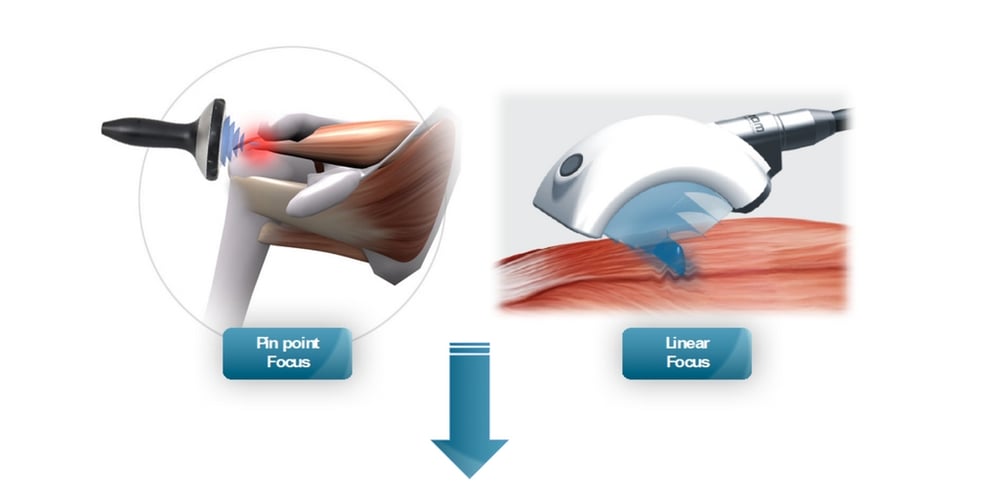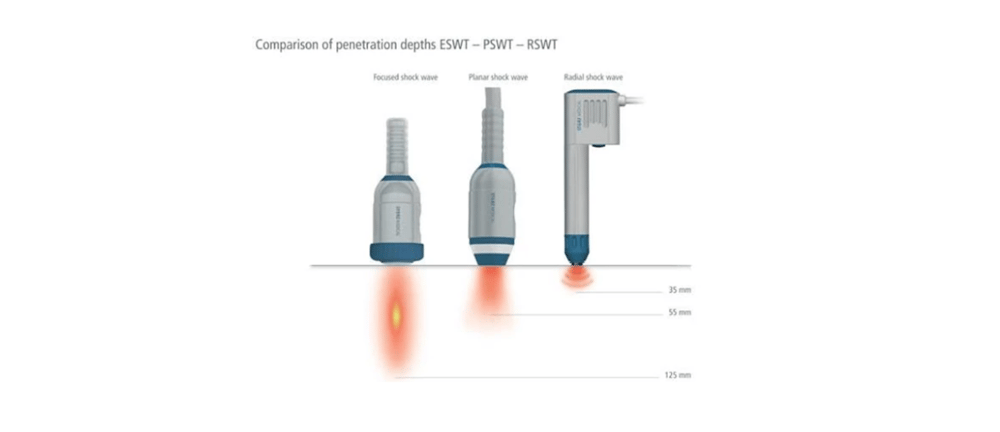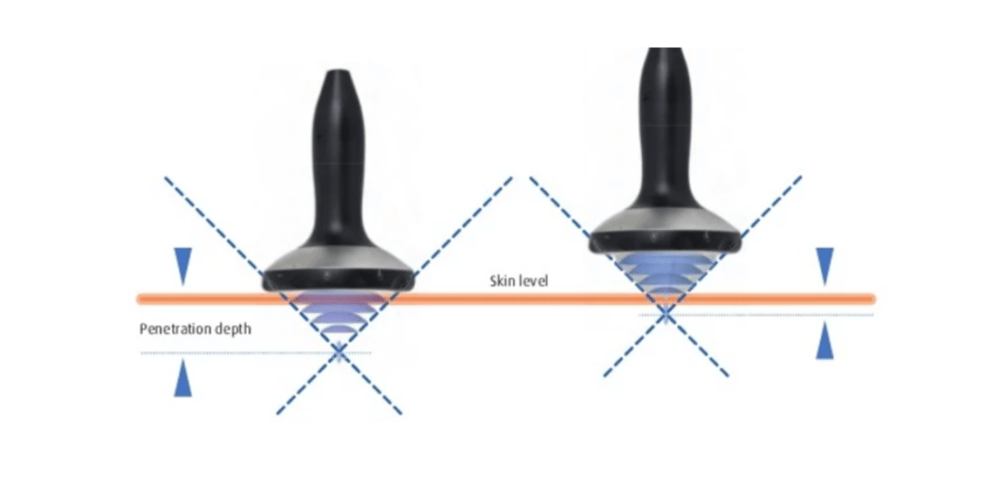"Ultrasound Guided Shockwave" Written by Paul Williamson, Director at The Performance Physio
Introduction
We are entering a new era of health care moving towards regenerative sports medicine. Ultrasound Guided Focused Shockwave Therapy utilises the latest technological advances to deliver a non-invasive therapeutic stimulus in the form of an acoustic signal. This mechanical stimulus is converted into a biological reaction which has been highly effective in treating both acute and chronic musculoskeletal conditions.

What is Extracorporeal Shockwave Therapy (ESWT)
ESWT is a non-invasive medical procedure used to treat both acute and chronic musculoskeletal conditions. The technology was developed from extracorporeal shockwave lithotripsy procedures in which acoustic shockwaves were used to break up kidney stones. ESWT has established itself in the management of many musculoskeletal conditions, particularly those stubborn to recover, as an alternative to injections and surgery.
Are all shockwave technologies the same? Focused versus Radial.
Focused
Piezoelectric, electromagnetic, and electrohydraulic technologies generate so-called ‘true shockwaves’ which can be used in Focused ESWT. PiezoWave Extracorporeal Focused Shockwaves are generated outside the body and then delivered to a focal target area deep inside the body. PiezoWave is the only technology that can create a shockwave which forms direct at the focus of treatment to ensure the delivered energy is maintained.

Radial
Radial Shockwaves are actually pressure waves and differ considerably from focused shockwaves. The energy spreads radially on contact with tissues and the density of energy dissipates rapidly through the top layers of the skin reducing penetration depth. This makes Radial systems unsuitable for targeted deeper areas classically associated with ESWT applications.

How does Focused Extracorporeal Shockwave Therapy work?
The PiezoWave focused shockwaves reach their peak pressure precisely on the target tissue. This mechanical stimulus known as mechanotransduction induces biochemical changes in living tissue which, on a molecular level affects gene expression and can promote cell growth, protein synthesis, release of growth factors, stimulation of stem cells and lubricin production. This can also exert an anti-inflammatory and antibacterial effect whilst promoting microcirculation and metabolic activity. It is one of the few technologies that has been shown to effectively treat pain syndromes of the musculoskeletal system.

Why Ultrasound Guided Shockwave Therapy?
Treatment commences with a diagnostic ultrasound scan of the tissues, we can identify the area of concern, map the focal region including target size and depth. Following this we can mark the area to be treated and set appropriate depth to ensure the focused shockwaves arrive at the desired point. Diagnostic ultrasound allows us to image any change in tissues that occur over time to monitor healing processes. This method guarantees precision is achieved in identifying areas of injury and accurate implementation of the treatment modality.
Range of Indications
Musculoskeletal diseases are among the most common disorders of the human body. Considerable research has been conducted into the efficacy of ESWT and its use in the management of these conditions. Consensus is yet to be reached regarding the physiological effects but the success rates are high ranging from 65% to 91% and complication rates are low. The quality of research conducted thus far is variable with both focused and radial ESWT grouped within the same treatment approach which may skew outcomes.
The most important finding is that a progressive exercise program improves the effectiveness and outcomes of ESWT treatment. Here at ‘The Performance Physio’ we have reviewed the literature and created specific exercise loading protocols to ensure we get the best outcome for our patients. Every patient undergoing ESWT will gain access to a specific exercise protocol, the library of video-based exercises and a bespoke rehabilitation plan to maximise the effectiveness of treatments.
Indications
Back Pain
Plantar Fascitis
Medial Tibial Stress Syndrome
Knee Meniscal Tears
Knee Osteo-Arthritis
Stress Fractures and Non-Unions
Tendon Pathologies (Achilles / Patella / Gluteal / Hamstring / Adductor)
Rotator Cuff Calcific Tendonitis
Golf & Tennis Elbow
Carpal Tunnel Syndrome
Myofascial Pain Syndrome
Cellulite
What Does the Research Say?
I have reviewed over 40 up to date articles comprising of meta analyses, systematic reviews and randomised controlled trials for the identified 24 treatment areas. Here are a few that highlight the effectiveness of ESWT in managing a variety of musculoskeletal conditions.
Achilles Tendinopathy.
Fan et al 2020 completed a Meta-analysis which looked at the efficacy of ESWT for Achilles tendinopathy. The principal finding of this study was that patients who received ESWT for Achilles tendinopathy had significantly better pain and functional outcomes than patients who received other treatments, including sham ESWT, eccentric training, and other traditional treatments at both 3 and 12 months follow up.
Rhim et al 2020 conducted a systematic review for comparative efficacy and tolerability of non-surgical therapies for the treatment of midportion Achilles. This review of 22 studies which included 978 patients found long term improvement was higher in the exercise groups when combined with ESWT or injections.
Carpal Tunnel Syndrome.
Atthakomol et al 2018 conducted a prospective randomized controlled trial to compare a single-dose of ESWT and local corticosteroid injection for treatment of carpal tunnel syndrome. Based on the results of this study, a single-dose of ESWT provides longer-lasting benefits than local Corticosteroid injection in the treatment of mild to moderate carpal tunnel syndrome.
Back Pain
Walewicz et al 2019 conducted a randomised controlled trial to observe the effectiveness of ESWT in patients with chronic low back pain. The study concluded that ESWT combined with stabilization training is particularly effective in the long-term and achieves a stable beneficial effect for patients with LBP.
Nedelka et al 2014 observed the mechano-transduction effect of shockwaves in the treatment of lumbar facet joint pain. They looked at the comparative effectiveness evaluation of shockwave therapy, steroid injections and radiofrequency medial branch neurotomy. This study indicted shockwave therapy displayed better long-term pain relief and daily activities compared to the facet joint injections group and little inferior efficacy compared to Radiofrequency. Additionally they observed that there was no change in outcome for neuropathic pain and therefore ESWT was not indicated as a treatment modality.
Moon et al 2017 looked at ESWT for sacroiliac joint pain. This randomised controlled trial found there was a significant group difference in pain at week 4 post-treatment favouring the ESWT group vs. the sham control group. They concluded ESWT represents a potential therapeutic option for decreasing sacroiliac joint pain.
References
Atthakomol et al 2018. BMC Musculoskeletal Disorders. 19:32
Fan et al 2020: The Orthopaedic Journal of Sports Medicine. 82
Moon et al 2017. Journal of Back and Musculoskeletal Rehabilitation. 30.4: 779-784
Nedelka et al 2014. Neuroendocrinology. 35.5
Rhim et al 2020. The Orthopaedic Journal of Sports Medicine 8.7
Walewicz et al 2019. Clinical Interventions in Aging.14. 1859-69
To keep up to date with our Blogs, Webinars and Courses. Sign up to our newsletter!
